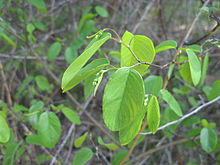Berchemia scandens
| Berchemia scandens | |
|---|---|

| |
| Scientific classification | |
| Kingdom: | Plantae |
| Clade: | Tracheophytes |
| Clade: | Angiosperms |
| Clade: | Eudicots |
| Clade: | Rosids |
| Order: | Rosales |
| Family: | Rhamnaceae |
| Genus: | Berchemia |
| Species: | B. scandens
|
| Binomial name | |
| Berchemia scandens (Hill) K. Koch[1]
| |
Berchemia scandens, commonly called Alabama supplejack,[2] is a species of climbing plant in the buckthorn family. It is native to the central and southern parts of the United States.[3] It is found in a wide variety of habitats, including swamps, bottomlands, riparian banks, and upland calcareous areas.[4]
It is a woody vine, with older stems reaching 18 cm in diameter.[4] The strong stems of the plant are often used for wickerwork.[5] It produces flowers in the spring
Traditional medicinal uses[edit]
The Houma people used a decoction of the aerial parts of the vine for impotency. Other Native Americans used the plant as a blood purifier and the ashes of the vine to treat coughs.[6]
References[edit]
Wikispecies has information related to Berchemia scandens.
Wikimedia Commons has media related to Berchemia scandens.
- ^ "Berchemia scandens (Hill) K.Koch". www.theplantlist.org. Royal Botanic Gardens, Kew and Missouri Botanical Garden. Retrieved 4 December 2016.
- ^ USDA, NRCS (n.d.). "Berchemia scandens". The PLANTS Database (plants.usda.gov). Greensboro, North Carolina: National Plant Data Team. Retrieved 8 January 2018.
- ^ "Berchemia scandens". County-level distribution map from the North American Plant Atlas (NAPA). Biota of North America Program (BONAP). 2014. Retrieved 9 January 2017.
- ^ a b Alan Weakley (2015). "Flora of the Southern and Mid-Atlantic States".
- ^ "Berchemia scandens". www.missouribotanicalgarden.org. Missouri Botanical Garden. Retrieved 4 December 2016.
- ^ Moerman, Daniel (2009). Native American Medicinal Plants: An Ethnobotanical Dictionary. Timber Press.
